Analysis of Risk Management Programs in Healthcare Organizations
VerifiedAdded on 2022/08/20
|11
|2987
|16
Report
AI Summary
This report analyzes a student's interview with healthcare professionals from South Nassau communities' hospitals to understand the operation of risk management programs. The interview explores risk management strategies such as risk avoidance, risk reduction, and establishing a just culture, providing examples like the use of MBA for treating patients with obstructive sleep apnea and the hardwiring of risk-mitigating practices. It addresses educational programs on professional, legal, and ethical issues, focusing on the prevention of negligence, malpractice, and vicarious liability. The report also examines policies for managing emergency triage, including narcotics inventories and blood-borne disease protocols, and discusses challenges such as infectious diseases, home-induced abortions, and the use of nuclear medicine. The interview highlights strategies for monitoring, evaluating, and maintaining compliance within the risk management program, including delegation of supervisory duties, weekly staff meetings, and patient monitoring. The report concludes with an assessment of the organization's risk management program, emphasizing the importance of education, documentation, collaboration, and incident reporting in mitigating risks and ensuring patient safety.
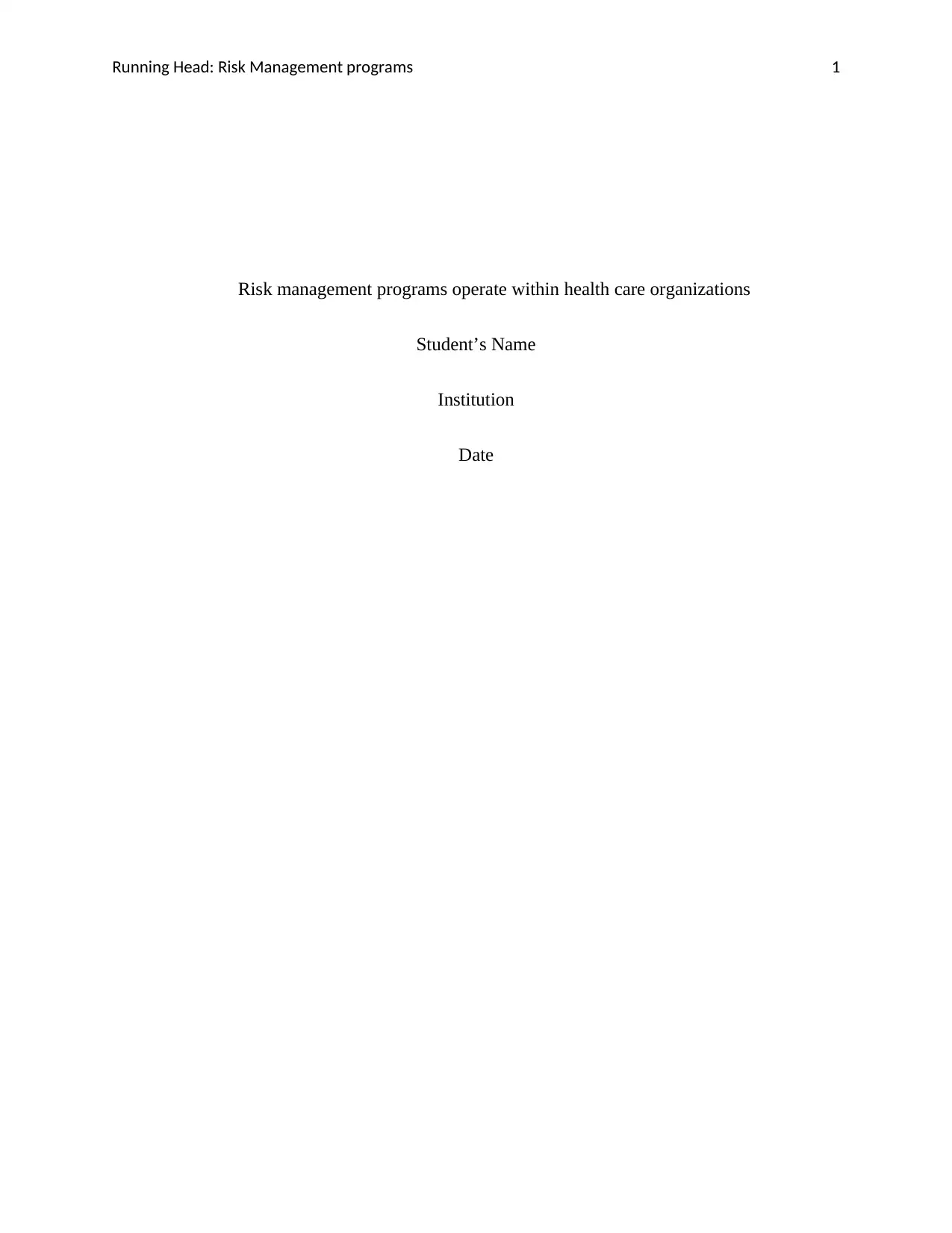
Running Head: Risk Management programs 1
Risk management programs operate within health care organizations
Student’s Name
Institution
Date
Risk management programs operate within health care organizations
Student’s Name
Institution
Date
Paraphrase This Document
Need a fresh take? Get an instant paraphrase of this document with our AI Paraphraser
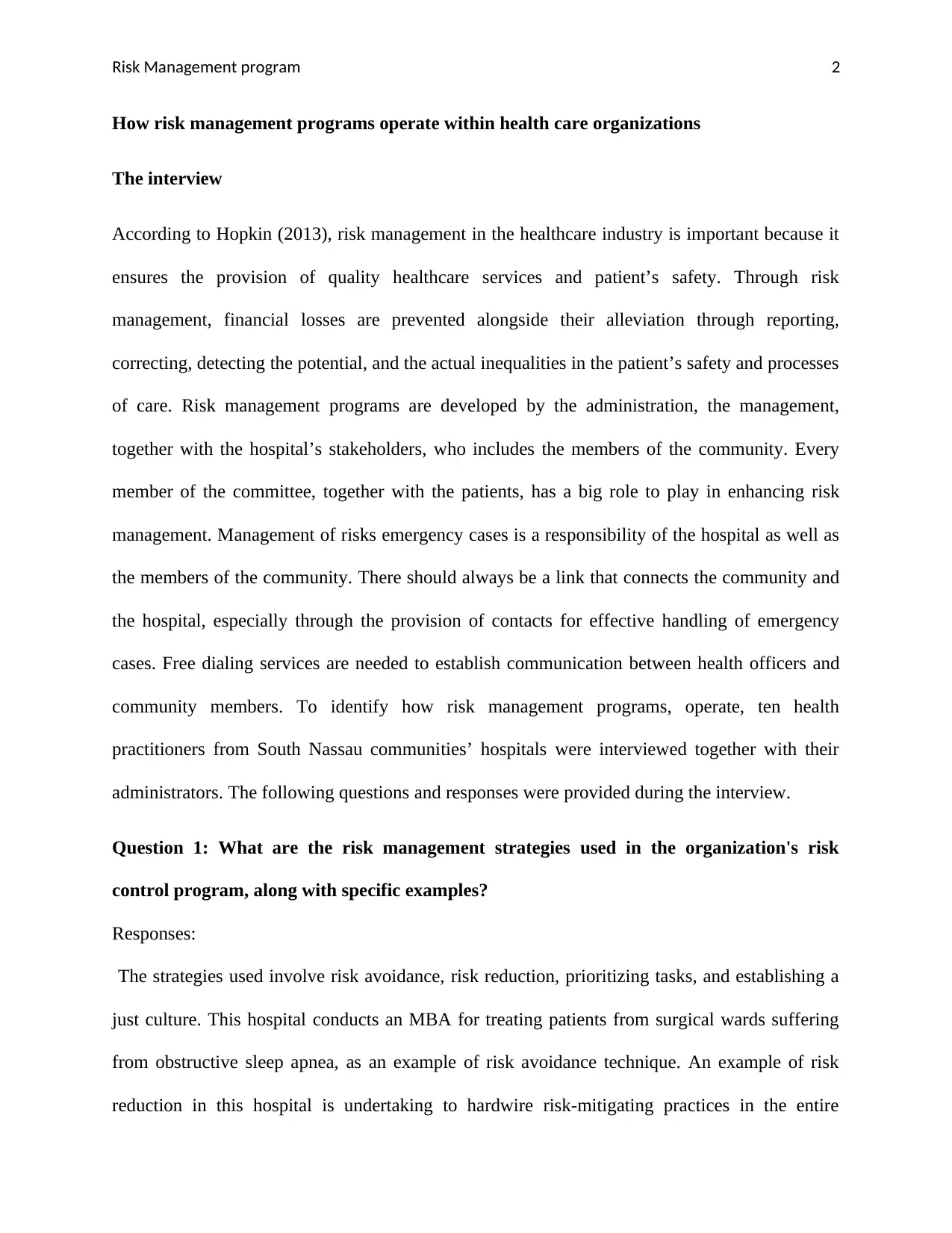
Risk Management program 2
How risk management programs operate within health care organizations
The interview
According to Hopkin (2013), risk management in the healthcare industry is important because it
ensures the provision of quality healthcare services and patient’s safety. Through risk
management, financial losses are prevented alongside their alleviation through reporting,
correcting, detecting the potential, and the actual inequalities in the patient’s safety and processes
of care. Risk management programs are developed by the administration, the management,
together with the hospital’s stakeholders, who includes the members of the community. Every
member of the committee, together with the patients, has a big role to play in enhancing risk
management. Management of risks emergency cases is a responsibility of the hospital as well as
the members of the community. There should always be a link that connects the community and
the hospital, especially through the provision of contacts for effective handling of emergency
cases. Free dialing services are needed to establish communication between health officers and
community members. To identify how risk management programs, operate, ten health
practitioners from South Nassau communities’ hospitals were interviewed together with their
administrators. The following questions and responses were provided during the interview.
Question 1: What are the risk management strategies used in the organization's risk
control program, along with specific examples?
Responses:
The strategies used involve risk avoidance, risk reduction, prioritizing tasks, and establishing a
just culture. This hospital conducts an MBA for treating patients from surgical wards suffering
from obstructive sleep apnea, as an example of risk avoidance technique. An example of risk
reduction in this hospital is undertaking to hardwire risk-mitigating practices in the entire
How risk management programs operate within health care organizations
The interview
According to Hopkin (2013), risk management in the healthcare industry is important because it
ensures the provision of quality healthcare services and patient’s safety. Through risk
management, financial losses are prevented alongside their alleviation through reporting,
correcting, detecting the potential, and the actual inequalities in the patient’s safety and processes
of care. Risk management programs are developed by the administration, the management,
together with the hospital’s stakeholders, who includes the members of the community. Every
member of the committee, together with the patients, has a big role to play in enhancing risk
management. Management of risks emergency cases is a responsibility of the hospital as well as
the members of the community. There should always be a link that connects the community and
the hospital, especially through the provision of contacts for effective handling of emergency
cases. Free dialing services are needed to establish communication between health officers and
community members. To identify how risk management programs, operate, ten health
practitioners from South Nassau communities’ hospitals were interviewed together with their
administrators. The following questions and responses were provided during the interview.
Question 1: What are the risk management strategies used in the organization's risk
control program, along with specific examples?
Responses:
The strategies used involve risk avoidance, risk reduction, prioritizing tasks, and establishing a
just culture. This hospital conducts an MBA for treating patients from surgical wards suffering
from obstructive sleep apnea, as an example of risk avoidance technique. An example of risk
reduction in this hospital is undertaking to hardwire risk-mitigating practices in the entire
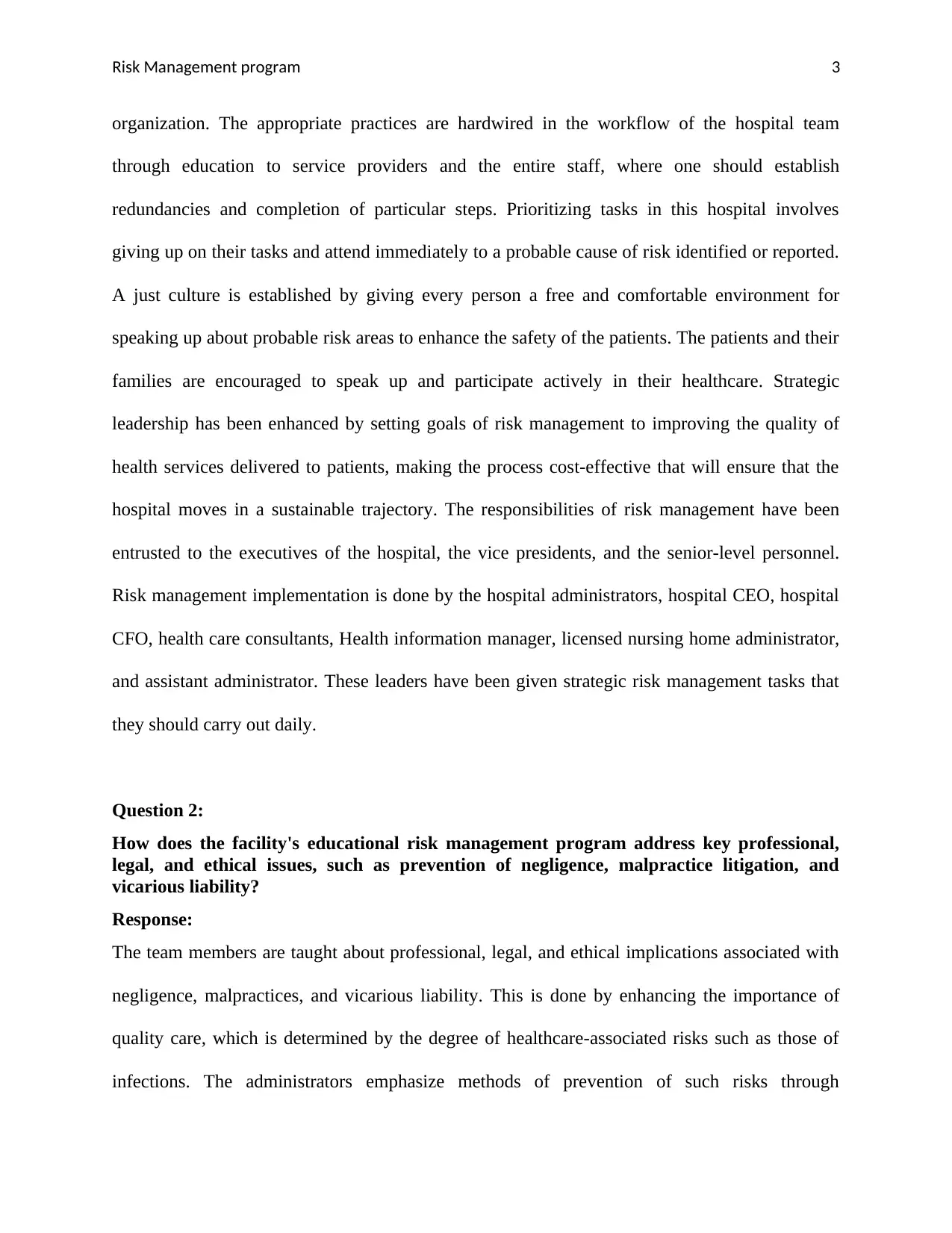
Risk Management program 3
organization. The appropriate practices are hardwired in the workflow of the hospital team
through education to service providers and the entire staff, where one should establish
redundancies and completion of particular steps. Prioritizing tasks in this hospital involves
giving up on their tasks and attend immediately to a probable cause of risk identified or reported.
A just culture is established by giving every person a free and comfortable environment for
speaking up about probable risk areas to enhance the safety of the patients. The patients and their
families are encouraged to speak up and participate actively in their healthcare. Strategic
leadership has been enhanced by setting goals of risk management to improving the quality of
health services delivered to patients, making the process cost-effective that will ensure that the
hospital moves in a sustainable trajectory. The responsibilities of risk management have been
entrusted to the executives of the hospital, the vice presidents, and the senior-level personnel.
Risk management implementation is done by the hospital administrators, hospital CEO, hospital
CFO, health care consultants, Health information manager, licensed nursing home administrator,
and assistant administrator. These leaders have been given strategic risk management tasks that
they should carry out daily.
Question 2:
How does the facility's educational risk management program address key professional,
legal, and ethical issues, such as prevention of negligence, malpractice litigation, and
vicarious liability?
Response:
The team members are taught about professional, legal, and ethical implications associated with
negligence, malpractices, and vicarious liability. This is done by enhancing the importance of
quality care, which is determined by the degree of healthcare-associated risks such as those of
infections. The administrators emphasize methods of prevention of such risks through
organization. The appropriate practices are hardwired in the workflow of the hospital team
through education to service providers and the entire staff, where one should establish
redundancies and completion of particular steps. Prioritizing tasks in this hospital involves
giving up on their tasks and attend immediately to a probable cause of risk identified or reported.
A just culture is established by giving every person a free and comfortable environment for
speaking up about probable risk areas to enhance the safety of the patients. The patients and their
families are encouraged to speak up and participate actively in their healthcare. Strategic
leadership has been enhanced by setting goals of risk management to improving the quality of
health services delivered to patients, making the process cost-effective that will ensure that the
hospital moves in a sustainable trajectory. The responsibilities of risk management have been
entrusted to the executives of the hospital, the vice presidents, and the senior-level personnel.
Risk management implementation is done by the hospital administrators, hospital CEO, hospital
CFO, health care consultants, Health information manager, licensed nursing home administrator,
and assistant administrator. These leaders have been given strategic risk management tasks that
they should carry out daily.
Question 2:
How does the facility's educational risk management program address key professional,
legal, and ethical issues, such as prevention of negligence, malpractice litigation, and
vicarious liability?
Response:
The team members are taught about professional, legal, and ethical implications associated with
negligence, malpractices, and vicarious liability. This is done by enhancing the importance of
quality care, which is determined by the degree of healthcare-associated risks such as those of
infections. The administrators emphasize methods of prevention of such risks through
⊘ This is a preview!⊘
Do you want full access?
Subscribe today to unlock all pages.

Trusted by 1+ million students worldwide
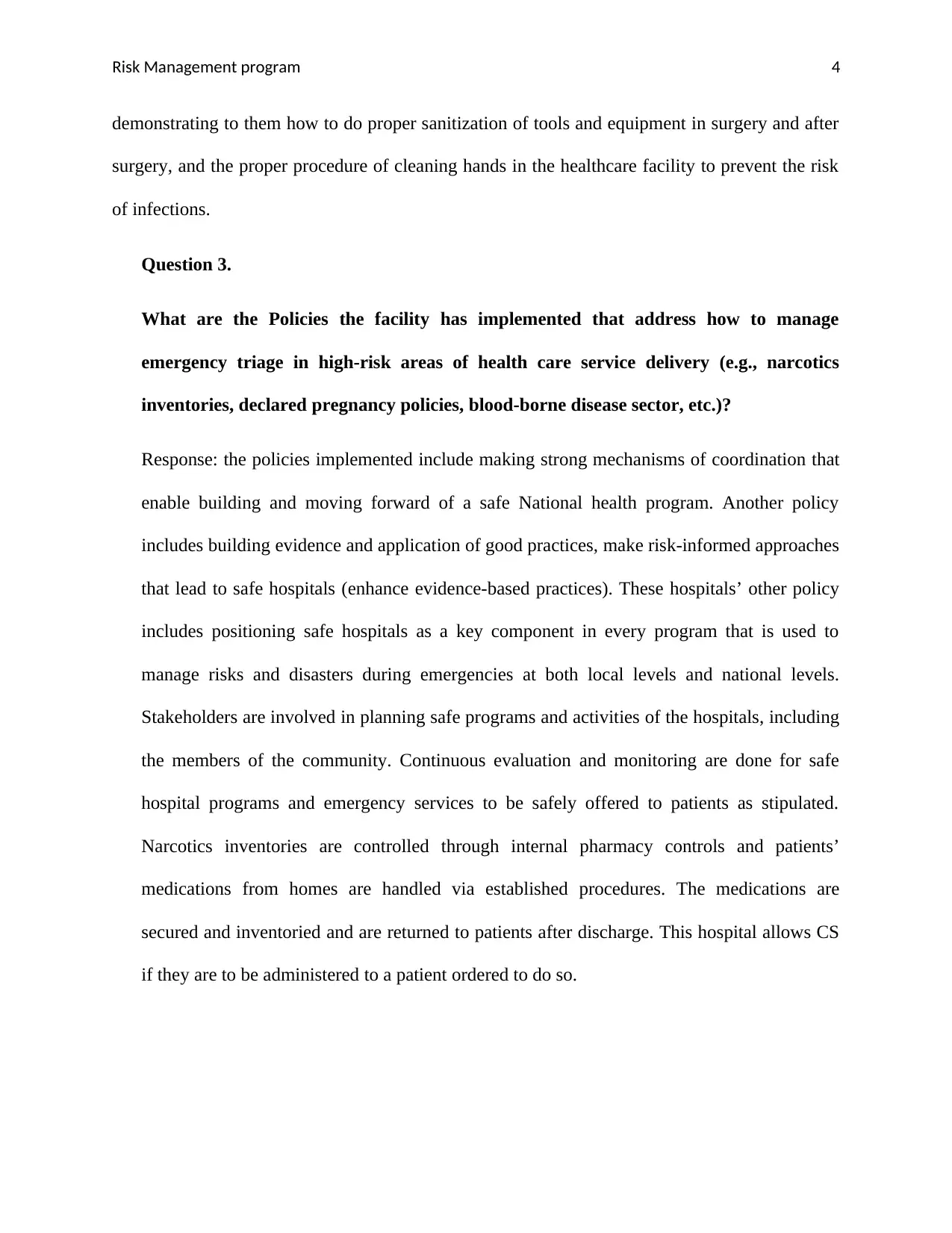
Risk Management program 4
demonstrating to them how to do proper sanitization of tools and equipment in surgery and after
surgery, and the proper procedure of cleaning hands in the healthcare facility to prevent the risk
of infections.
Question 3.
What are the Policies the facility has implemented that address how to manage
emergency triage in high‐risk areas of health care service delivery (e.g., narcotics
inventories, declared pregnancy policies, blood-borne disease sector, etc.)?
Response: the policies implemented include making strong mechanisms of coordination that
enable building and moving forward of a safe National health program. Another policy
includes building evidence and application of good practices, make risk-informed approaches
that lead to safe hospitals (enhance evidence-based practices). These hospitals’ other policy
includes positioning safe hospitals as a key component in every program that is used to
manage risks and disasters during emergencies at both local levels and national levels.
Stakeholders are involved in planning safe programs and activities of the hospitals, including
the members of the community. Continuous evaluation and monitoring are done for safe
hospital programs and emergency services to be safely offered to patients as stipulated.
Narcotics inventories are controlled through internal pharmacy controls and patients’
medications from homes are handled via established procedures. The medications are
secured and inventoried and are returned to patients after discharge. This hospital allows CS
if they are to be administered to a patient ordered to do so.
demonstrating to them how to do proper sanitization of tools and equipment in surgery and after
surgery, and the proper procedure of cleaning hands in the healthcare facility to prevent the risk
of infections.
Question 3.
What are the Policies the facility has implemented that address how to manage
emergency triage in high‐risk areas of health care service delivery (e.g., narcotics
inventories, declared pregnancy policies, blood-borne disease sector, etc.)?
Response: the policies implemented include making strong mechanisms of coordination that
enable building and moving forward of a safe National health program. Another policy
includes building evidence and application of good practices, make risk-informed approaches
that lead to safe hospitals (enhance evidence-based practices). These hospitals’ other policy
includes positioning safe hospitals as a key component in every program that is used to
manage risks and disasters during emergencies at both local levels and national levels.
Stakeholders are involved in planning safe programs and activities of the hospitals, including
the members of the community. Continuous evaluation and monitoring are done for safe
hospital programs and emergency services to be safely offered to patients as stipulated.
Narcotics inventories are controlled through internal pharmacy controls and patients’
medications from homes are handled via established procedures. The medications are
secured and inventoried and are returned to patients after discharge. This hospital allows CS
if they are to be administered to a patient ordered to do so.
Paraphrase This Document
Need a fresh take? Get an instant paraphrase of this document with our AI Paraphraser
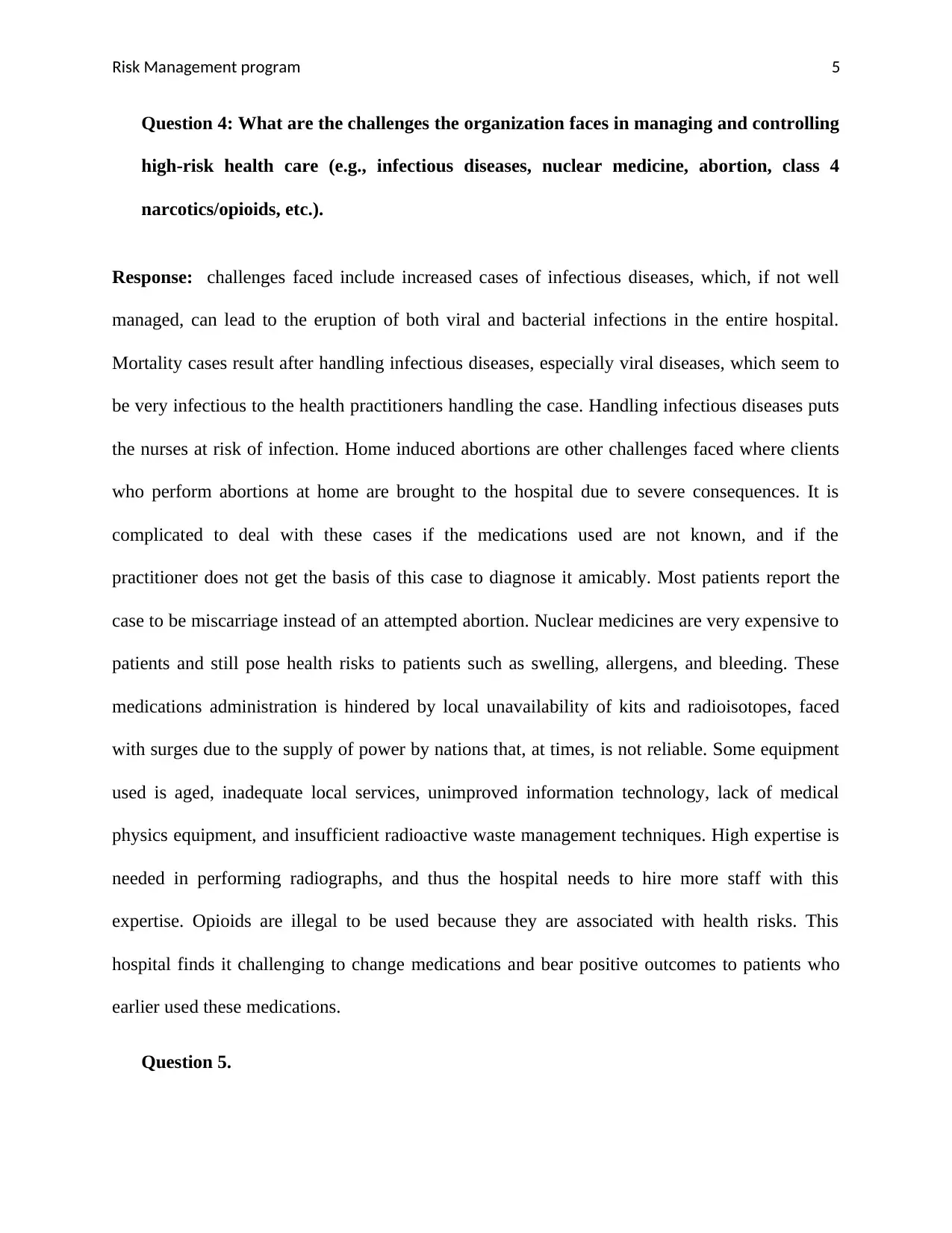
Risk Management program 5
Question 4: What are the challenges the organization faces in managing and controlling
high-risk health care (e.g., infectious diseases, nuclear medicine, abortion, class 4
narcotics/opioids, etc.).
Response: challenges faced include increased cases of infectious diseases, which, if not well
managed, can lead to the eruption of both viral and bacterial infections in the entire hospital.
Mortality cases result after handling infectious diseases, especially viral diseases, which seem to
be very infectious to the health practitioners handling the case. Handling infectious diseases puts
the nurses at risk of infection. Home induced abortions are other challenges faced where clients
who perform abortions at home are brought to the hospital due to severe consequences. It is
complicated to deal with these cases if the medications used are not known, and if the
practitioner does not get the basis of this case to diagnose it amicably. Most patients report the
case to be miscarriage instead of an attempted abortion. Nuclear medicines are very expensive to
patients and still pose health risks to patients such as swelling, allergens, and bleeding. These
medications administration is hindered by local unavailability of kits and radioisotopes, faced
with surges due to the supply of power by nations that, at times, is not reliable. Some equipment
used is aged, inadequate local services, unimproved information technology, lack of medical
physics equipment, and insufficient radioactive waste management techniques. High expertise is
needed in performing radiographs, and thus the hospital needs to hire more staff with this
expertise. Opioids are illegal to be used because they are associated with health risks. This
hospital finds it challenging to change medications and bear positive outcomes to patients who
earlier used these medications.
Question 5.
Question 4: What are the challenges the organization faces in managing and controlling
high-risk health care (e.g., infectious diseases, nuclear medicine, abortion, class 4
narcotics/opioids, etc.).
Response: challenges faced include increased cases of infectious diseases, which, if not well
managed, can lead to the eruption of both viral and bacterial infections in the entire hospital.
Mortality cases result after handling infectious diseases, especially viral diseases, which seem to
be very infectious to the health practitioners handling the case. Handling infectious diseases puts
the nurses at risk of infection. Home induced abortions are other challenges faced where clients
who perform abortions at home are brought to the hospital due to severe consequences. It is
complicated to deal with these cases if the medications used are not known, and if the
practitioner does not get the basis of this case to diagnose it amicably. Most patients report the
case to be miscarriage instead of an attempted abortion. Nuclear medicines are very expensive to
patients and still pose health risks to patients such as swelling, allergens, and bleeding. These
medications administration is hindered by local unavailability of kits and radioisotopes, faced
with surges due to the supply of power by nations that, at times, is not reliable. Some equipment
used is aged, inadequate local services, unimproved information technology, lack of medical
physics equipment, and insufficient radioactive waste management techniques. High expertise is
needed in performing radiographs, and thus the hospital needs to hire more staff with this
expertise. Opioids are illegal to be used because they are associated with health risks. This
hospital finds it challenging to change medications and bear positive outcomes to patients who
earlier used these medications.
Question 5.
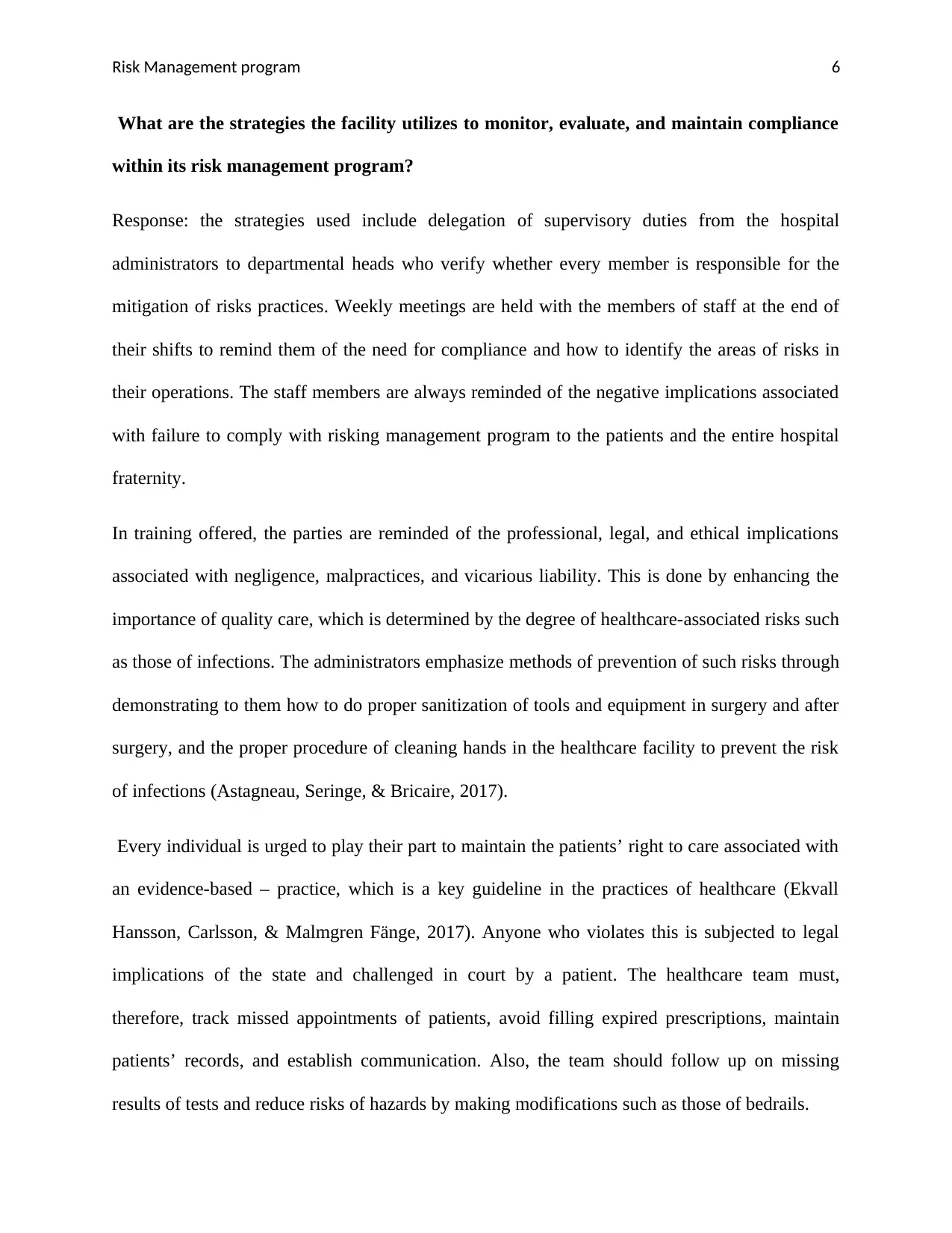
Risk Management program 6
What are the strategies the facility utilizes to monitor, evaluate, and maintain compliance
within its risk management program?
Response: the strategies used include delegation of supervisory duties from the hospital
administrators to departmental heads who verify whether every member is responsible for the
mitigation of risks practices. Weekly meetings are held with the members of staff at the end of
their shifts to remind them of the need for compliance and how to identify the areas of risks in
their operations. The staff members are always reminded of the negative implications associated
with failure to comply with risking management program to the patients and the entire hospital
fraternity.
In training offered, the parties are reminded of the professional, legal, and ethical implications
associated with negligence, malpractices, and vicarious liability. This is done by enhancing the
importance of quality care, which is determined by the degree of healthcare-associated risks such
as those of infections. The administrators emphasize methods of prevention of such risks through
demonstrating to them how to do proper sanitization of tools and equipment in surgery and after
surgery, and the proper procedure of cleaning hands in the healthcare facility to prevent the risk
of infections (Astagneau, Seringe, & Bricaire, 2017).
Every individual is urged to play their part to maintain the patients’ right to care associated with
an evidence-based – practice, which is a key guideline in the practices of healthcare (Ekvall
Hansson, Carlsson, & Malmgren Fänge, 2017). Anyone who violates this is subjected to legal
implications of the state and challenged in court by a patient. The healthcare team must,
therefore, track missed appointments of patients, avoid filling expired prescriptions, maintain
patients’ records, and establish communication. Also, the team should follow up on missing
results of tests and reduce risks of hazards by making modifications such as those of bedrails.
What are the strategies the facility utilizes to monitor, evaluate, and maintain compliance
within its risk management program?
Response: the strategies used include delegation of supervisory duties from the hospital
administrators to departmental heads who verify whether every member is responsible for the
mitigation of risks practices. Weekly meetings are held with the members of staff at the end of
their shifts to remind them of the need for compliance and how to identify the areas of risks in
their operations. The staff members are always reminded of the negative implications associated
with failure to comply with risking management program to the patients and the entire hospital
fraternity.
In training offered, the parties are reminded of the professional, legal, and ethical implications
associated with negligence, malpractices, and vicarious liability. This is done by enhancing the
importance of quality care, which is determined by the degree of healthcare-associated risks such
as those of infections. The administrators emphasize methods of prevention of such risks through
demonstrating to them how to do proper sanitization of tools and equipment in surgery and after
surgery, and the proper procedure of cleaning hands in the healthcare facility to prevent the risk
of infections (Astagneau, Seringe, & Bricaire, 2017).
Every individual is urged to play their part to maintain the patients’ right to care associated with
an evidence-based – practice, which is a key guideline in the practices of healthcare (Ekvall
Hansson, Carlsson, & Malmgren Fänge, 2017). Anyone who violates this is subjected to legal
implications of the state and challenged in court by a patient. The healthcare team must,
therefore, track missed appointments of patients, avoid filling expired prescriptions, maintain
patients’ records, and establish communication. Also, the team should follow up on missing
results of tests and reduce risks of hazards by making modifications such as those of bedrails.
⊘ This is a preview!⊘
Do you want full access?
Subscribe today to unlock all pages.

Trusted by 1+ million students worldwide
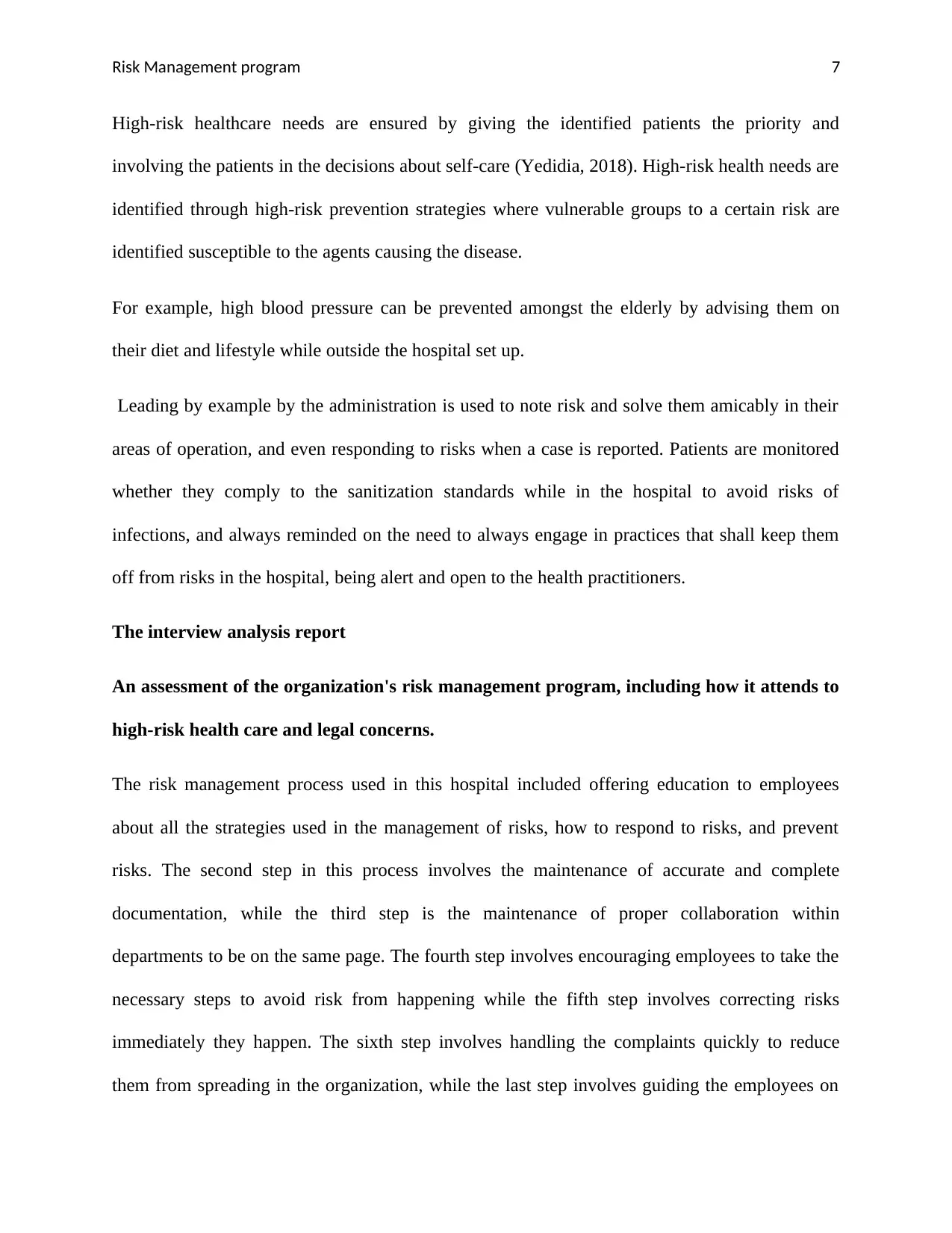
Risk Management program 7
High-risk healthcare needs are ensured by giving the identified patients the priority and
involving the patients in the decisions about self-care (Yedidia, 2018). High-risk health needs are
identified through high-risk prevention strategies where vulnerable groups to a certain risk are
identified susceptible to the agents causing the disease.
For example, high blood pressure can be prevented amongst the elderly by advising them on
their diet and lifestyle while outside the hospital set up.
Leading by example by the administration is used to note risk and solve them amicably in their
areas of operation, and even responding to risks when a case is reported. Patients are monitored
whether they comply to the sanitization standards while in the hospital to avoid risks of
infections, and always reminded on the need to always engage in practices that shall keep them
off from risks in the hospital, being alert and open to the health practitioners.
The interview analysis report
An assessment of the organization's risk management program, including how it attends to
high-risk health care and legal concerns.
The risk management process used in this hospital included offering education to employees
about all the strategies used in the management of risks, how to respond to risks, and prevent
risks. The second step in this process involves the maintenance of accurate and complete
documentation, while the third step is the maintenance of proper collaboration within
departments to be on the same page. The fourth step involves encouraging employees to take the
necessary steps to avoid risk from happening while the fifth step involves correcting risks
immediately they happen. The sixth step involves handling the complaints quickly to reduce
them from spreading in the organization, while the last step involves guiding the employees on
High-risk healthcare needs are ensured by giving the identified patients the priority and
involving the patients in the decisions about self-care (Yedidia, 2018). High-risk health needs are
identified through high-risk prevention strategies where vulnerable groups to a certain risk are
identified susceptible to the agents causing the disease.
For example, high blood pressure can be prevented amongst the elderly by advising them on
their diet and lifestyle while outside the hospital set up.
Leading by example by the administration is used to note risk and solve them amicably in their
areas of operation, and even responding to risks when a case is reported. Patients are monitored
whether they comply to the sanitization standards while in the hospital to avoid risks of
infections, and always reminded on the need to always engage in practices that shall keep them
off from risks in the hospital, being alert and open to the health practitioners.
The interview analysis report
An assessment of the organization's risk management program, including how it attends to
high-risk health care and legal concerns.
The risk management process used in this hospital included offering education to employees
about all the strategies used in the management of risks, how to respond to risks, and prevent
risks. The second step in this process involves the maintenance of accurate and complete
documentation, while the third step is the maintenance of proper collaboration within
departments to be on the same page. The fourth step involves encouraging employees to take the
necessary steps to avoid risk from happening while the fifth step involves correcting risks
immediately they happen. The sixth step involves handling the complaints quickly to reduce
them from spreading in the organization, while the last step involves guiding the employees on
Paraphrase This Document
Need a fresh take? Get an instant paraphrase of this document with our AI Paraphraser
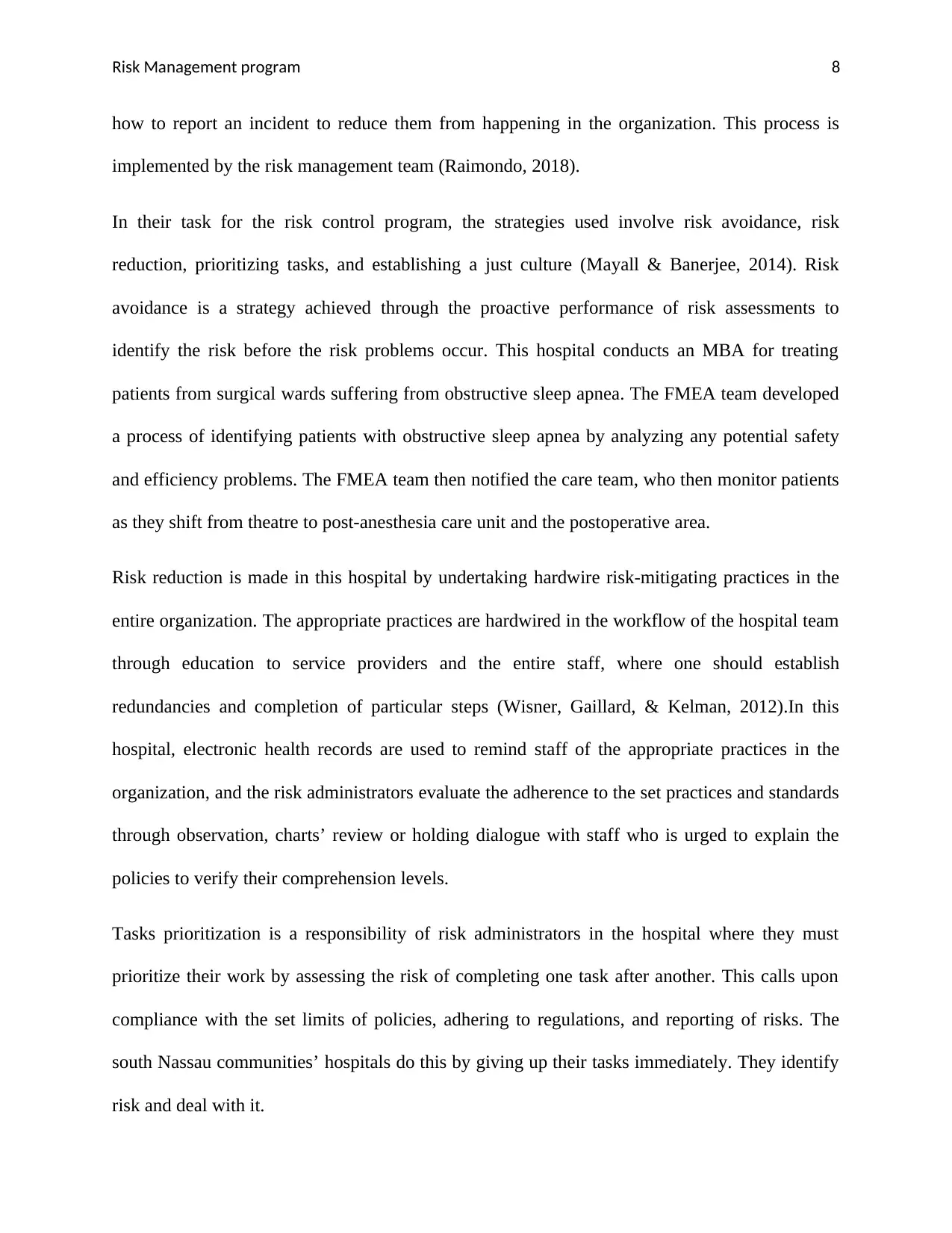
Risk Management program 8
how to report an incident to reduce them from happening in the organization. This process is
implemented by the risk management team (Raimondo, 2018).
In their task for the risk control program, the strategies used involve risk avoidance, risk
reduction, prioritizing tasks, and establishing a just culture (Mayall & Banerjee, 2014). Risk
avoidance is a strategy achieved through the proactive performance of risk assessments to
identify the risk before the risk problems occur. This hospital conducts an MBA for treating
patients from surgical wards suffering from obstructive sleep apnea. The FMEA team developed
a process of identifying patients with obstructive sleep apnea by analyzing any potential safety
and efficiency problems. The FMEA team then notified the care team, who then monitor patients
as they shift from theatre to post-anesthesia care unit and the postoperative area.
Risk reduction is made in this hospital by undertaking hardwire risk-mitigating practices in the
entire organization. The appropriate practices are hardwired in the workflow of the hospital team
through education to service providers and the entire staff, where one should establish
redundancies and completion of particular steps (Wisner, Gaillard, & Kelman, 2012).In this
hospital, electronic health records are used to remind staff of the appropriate practices in the
organization, and the risk administrators evaluate the adherence to the set practices and standards
through observation, charts’ review or holding dialogue with staff who is urged to explain the
policies to verify their comprehension levels.
Tasks prioritization is a responsibility of risk administrators in the hospital where they must
prioritize their work by assessing the risk of completing one task after another. This calls upon
compliance with the set limits of policies, adhering to regulations, and reporting of risks. The
south Nassau communities’ hospitals do this by giving up their tasks immediately. They identify
risk and deal with it.
how to report an incident to reduce them from happening in the organization. This process is
implemented by the risk management team (Raimondo, 2018).
In their task for the risk control program, the strategies used involve risk avoidance, risk
reduction, prioritizing tasks, and establishing a just culture (Mayall & Banerjee, 2014). Risk
avoidance is a strategy achieved through the proactive performance of risk assessments to
identify the risk before the risk problems occur. This hospital conducts an MBA for treating
patients from surgical wards suffering from obstructive sleep apnea. The FMEA team developed
a process of identifying patients with obstructive sleep apnea by analyzing any potential safety
and efficiency problems. The FMEA team then notified the care team, who then monitor patients
as they shift from theatre to post-anesthesia care unit and the postoperative area.
Risk reduction is made in this hospital by undertaking hardwire risk-mitigating practices in the
entire organization. The appropriate practices are hardwired in the workflow of the hospital team
through education to service providers and the entire staff, where one should establish
redundancies and completion of particular steps (Wisner, Gaillard, & Kelman, 2012).In this
hospital, electronic health records are used to remind staff of the appropriate practices in the
organization, and the risk administrators evaluate the adherence to the set practices and standards
through observation, charts’ review or holding dialogue with staff who is urged to explain the
policies to verify their comprehension levels.
Tasks prioritization is a responsibility of risk administrators in the hospital where they must
prioritize their work by assessing the risk of completing one task after another. This calls upon
compliance with the set limits of policies, adhering to regulations, and reporting of risks. The
south Nassau communities’ hospitals do this by giving up their tasks immediately. They identify
risk and deal with it.
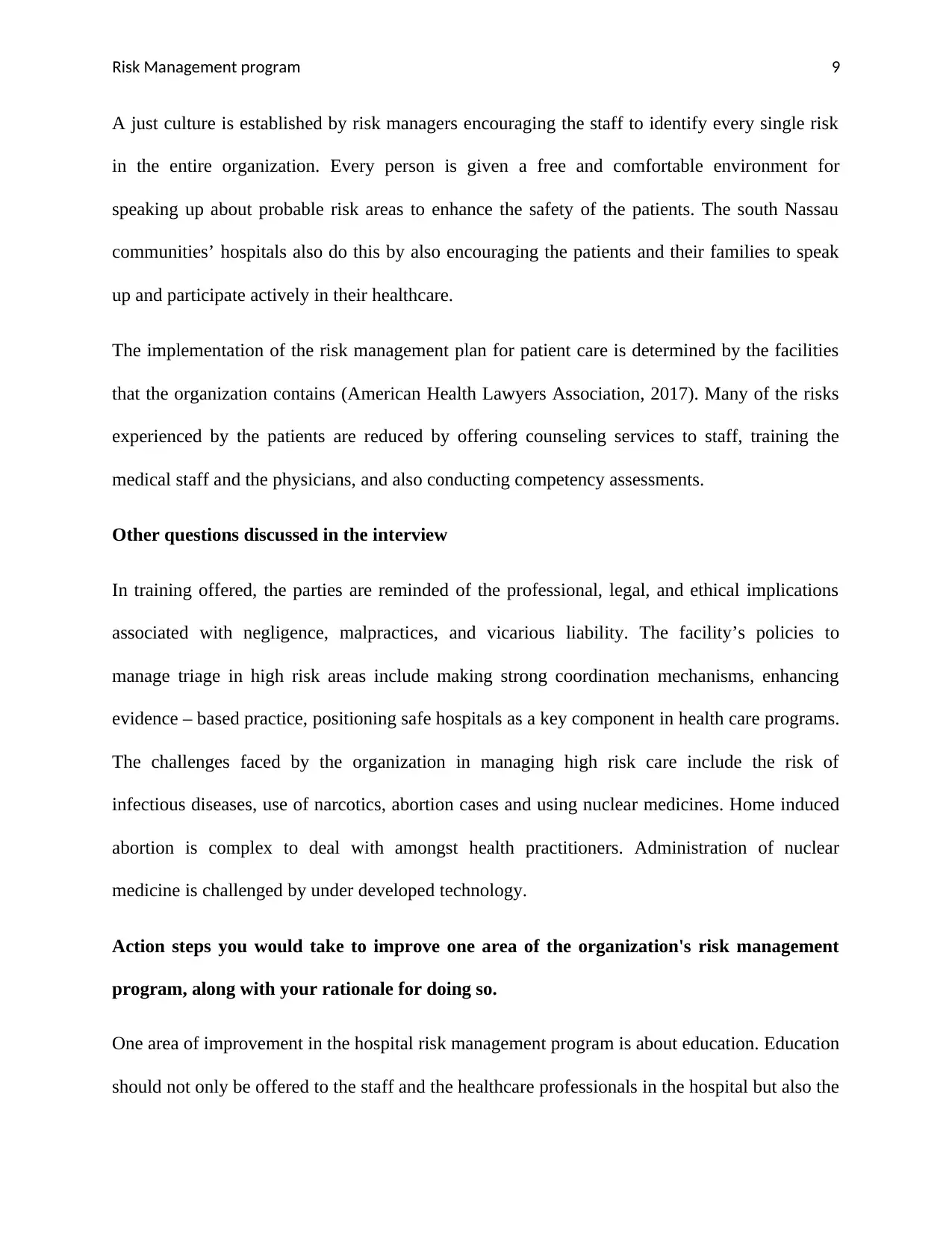
Risk Management program 9
A just culture is established by risk managers encouraging the staff to identify every single risk
in the entire organization. Every person is given a free and comfortable environment for
speaking up about probable risk areas to enhance the safety of the patients. The south Nassau
communities’ hospitals also do this by also encouraging the patients and their families to speak
up and participate actively in their healthcare.
The implementation of the risk management plan for patient care is determined by the facilities
that the organization contains (American Health Lawyers Association, 2017). Many of the risks
experienced by the patients are reduced by offering counseling services to staff, training the
medical staff and the physicians, and also conducting competency assessments.
Other questions discussed in the interview
In training offered, the parties are reminded of the professional, legal, and ethical implications
associated with negligence, malpractices, and vicarious liability. The facility’s policies to
manage triage in high risk areas include making strong coordination mechanisms, enhancing
evidence – based practice, positioning safe hospitals as a key component in health care programs.
The challenges faced by the organization in managing high risk care include the risk of
infectious diseases, use of narcotics, abortion cases and using nuclear medicines. Home induced
abortion is complex to deal with amongst health practitioners. Administration of nuclear
medicine is challenged by under developed technology.
Action steps you would take to improve one area of the organization's risk management
program, along with your rationale for doing so.
One area of improvement in the hospital risk management program is about education. Education
should not only be offered to the staff and the healthcare professionals in the hospital but also the
A just culture is established by risk managers encouraging the staff to identify every single risk
in the entire organization. Every person is given a free and comfortable environment for
speaking up about probable risk areas to enhance the safety of the patients. The south Nassau
communities’ hospitals also do this by also encouraging the patients and their families to speak
up and participate actively in their healthcare.
The implementation of the risk management plan for patient care is determined by the facilities
that the organization contains (American Health Lawyers Association, 2017). Many of the risks
experienced by the patients are reduced by offering counseling services to staff, training the
medical staff and the physicians, and also conducting competency assessments.
Other questions discussed in the interview
In training offered, the parties are reminded of the professional, legal, and ethical implications
associated with negligence, malpractices, and vicarious liability. The facility’s policies to
manage triage in high risk areas include making strong coordination mechanisms, enhancing
evidence – based practice, positioning safe hospitals as a key component in health care programs.
The challenges faced by the organization in managing high risk care include the risk of
infectious diseases, use of narcotics, abortion cases and using nuclear medicines. Home induced
abortion is complex to deal with amongst health practitioners. Administration of nuclear
medicine is challenged by under developed technology.
Action steps you would take to improve one area of the organization's risk management
program, along with your rationale for doing so.
One area of improvement in the hospital risk management program is about education. Education
should not only be offered to the staff and the healthcare professionals in the hospital but also the
⊘ This is a preview!⊘
Do you want full access?
Subscribe today to unlock all pages.

Trusted by 1+ million students worldwide
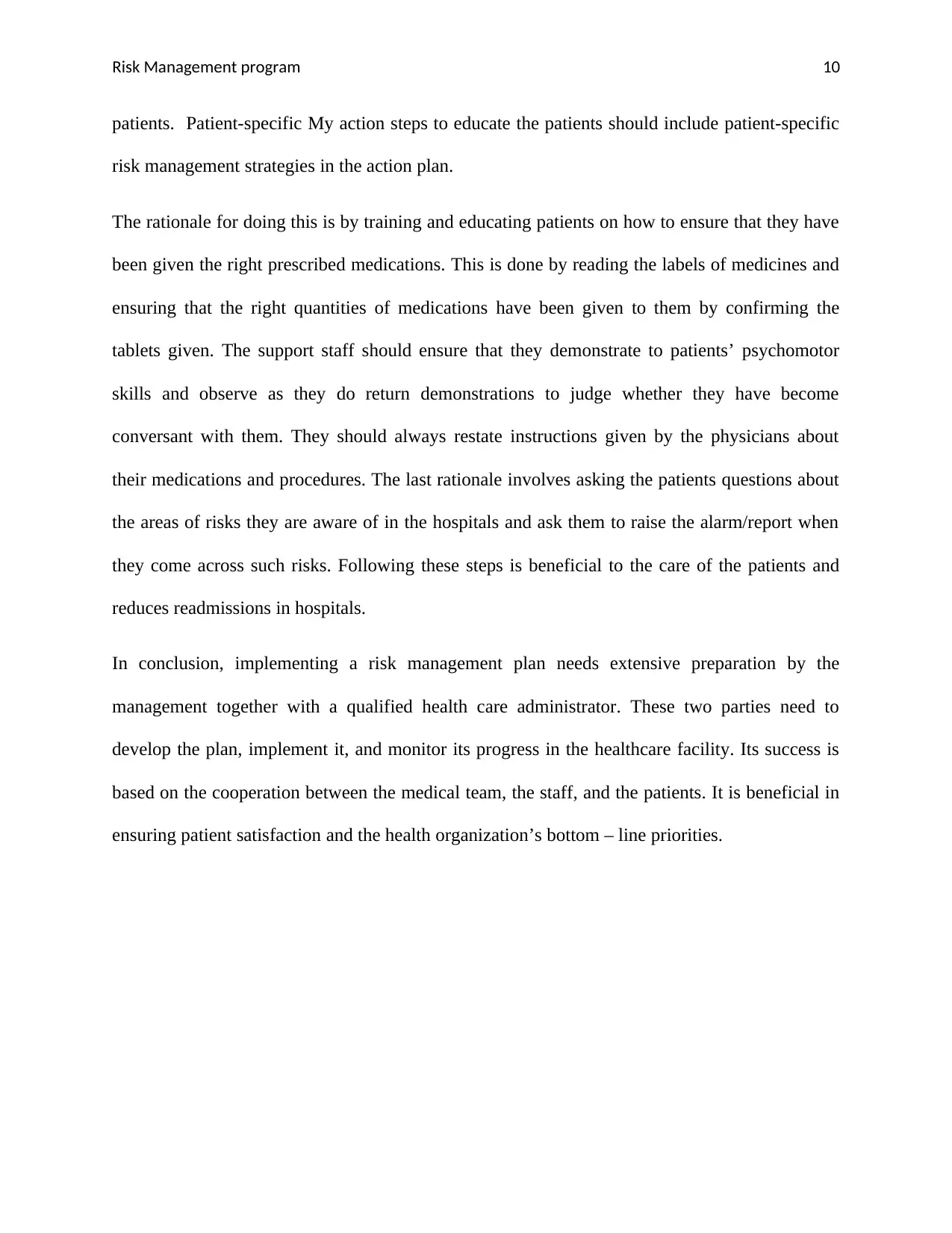
Risk Management program 10
patients. Patient-specific My action steps to educate the patients should include patient-specific
risk management strategies in the action plan.
The rationale for doing this is by training and educating patients on how to ensure that they have
been given the right prescribed medications. This is done by reading the labels of medicines and
ensuring that the right quantities of medications have been given to them by confirming the
tablets given. The support staff should ensure that they demonstrate to patients’ psychomotor
skills and observe as they do return demonstrations to judge whether they have become
conversant with them. They should always restate instructions given by the physicians about
their medications and procedures. The last rationale involves asking the patients questions about
the areas of risks they are aware of in the hospitals and ask them to raise the alarm/report when
they come across such risks. Following these steps is beneficial to the care of the patients and
reduces readmissions in hospitals.
In conclusion, implementing a risk management plan needs extensive preparation by the
management together with a qualified health care administrator. These two parties need to
develop the plan, implement it, and monitor its progress in the healthcare facility. Its success is
based on the cooperation between the medical team, the staff, and the patients. It is beneficial in
ensuring patient satisfaction and the health organization’s bottom – line priorities.
patients. Patient-specific My action steps to educate the patients should include patient-specific
risk management strategies in the action plan.
The rationale for doing this is by training and educating patients on how to ensure that they have
been given the right prescribed medications. This is done by reading the labels of medicines and
ensuring that the right quantities of medications have been given to them by confirming the
tablets given. The support staff should ensure that they demonstrate to patients’ psychomotor
skills and observe as they do return demonstrations to judge whether they have become
conversant with them. They should always restate instructions given by the physicians about
their medications and procedures. The last rationale involves asking the patients questions about
the areas of risks they are aware of in the hospitals and ask them to raise the alarm/report when
they come across such risks. Following these steps is beneficial to the care of the patients and
reduces readmissions in hospitals.
In conclusion, implementing a risk management plan needs extensive preparation by the
management together with a qualified health care administrator. These two parties need to
develop the plan, implement it, and monitor its progress in the healthcare facility. Its success is
based on the cooperation between the medical team, the staff, and the patients. It is beneficial in
ensuring patient satisfaction and the health organization’s bottom – line priorities.
Paraphrase This Document
Need a fresh take? Get an instant paraphrase of this document with our AI Paraphraser
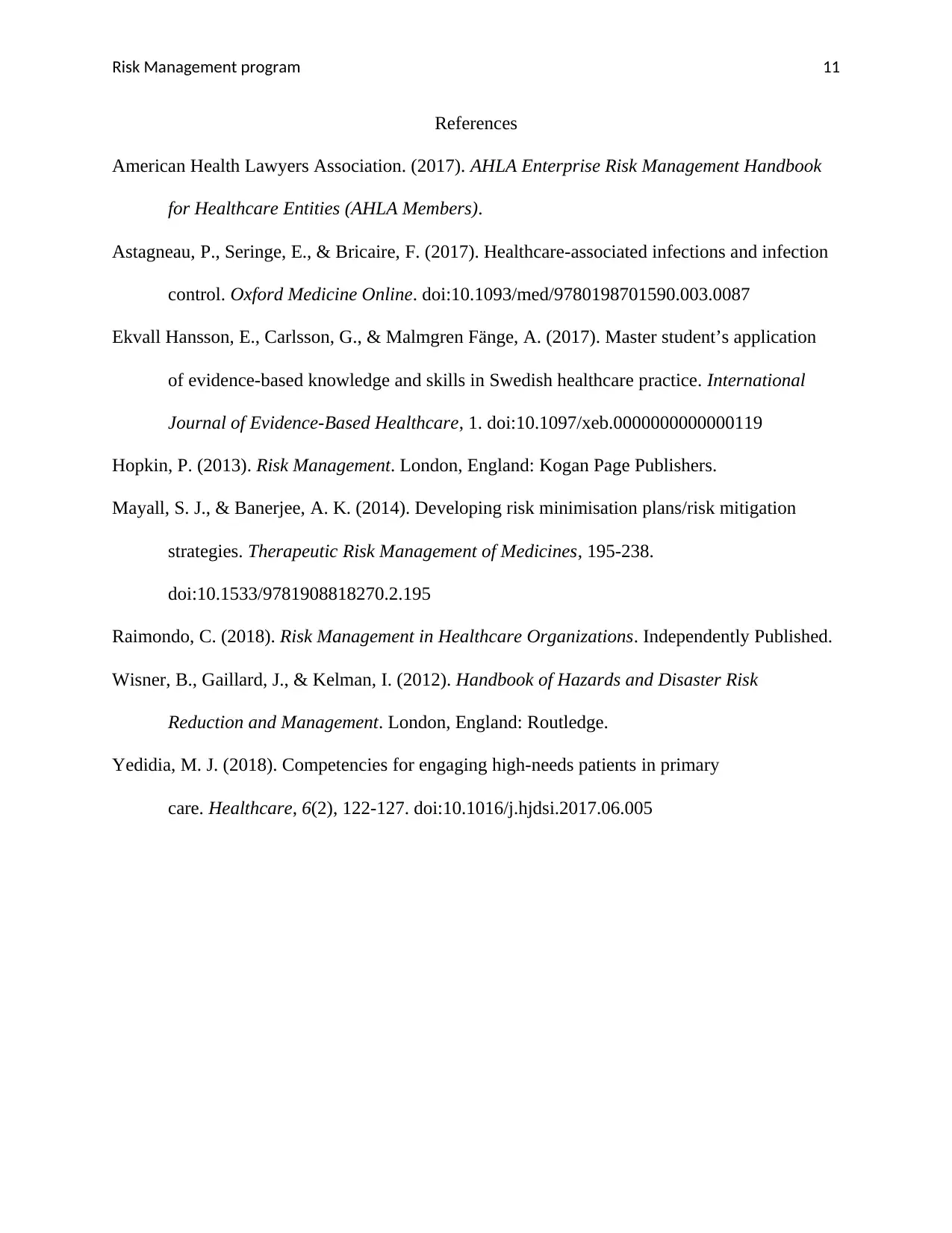
Risk Management program 11
References
American Health Lawyers Association. (2017). AHLA Enterprise Risk Management Handbook
for Healthcare Entities (AHLA Members).
Astagneau, P., Seringe, E., & Bricaire, F. (2017). Healthcare-associated infections and infection
control. Oxford Medicine Online. doi:10.1093/med/9780198701590.003.0087
Ekvall Hansson, E., Carlsson, G., & Malmgren Fänge, A. (2017). Master studentʼs application
of evidence-based knowledge and skills in Swedish healthcare practice. International
Journal of Evidence-Based Healthcare, 1. doi:10.1097/xeb.0000000000000119
Hopkin, P. (2013). Risk Management. London, England: Kogan Page Publishers.
Mayall, S. J., & Banerjee, A. K. (2014). Developing risk minimisation plans/risk mitigation
strategies. Therapeutic Risk Management of Medicines, 195-238.
doi:10.1533/9781908818270.2.195
Raimondo, C. (2018). Risk Management in Healthcare Organizations. Independently Published.
Wisner, B., Gaillard, J., & Kelman, I. (2012). Handbook of Hazards and Disaster Risk
Reduction and Management. London, England: Routledge.
Yedidia, M. J. (2018). Competencies for engaging high-needs patients in primary
care. Healthcare, 6(2), 122-127. doi:10.1016/j.hjdsi.2017.06.005
References
American Health Lawyers Association. (2017). AHLA Enterprise Risk Management Handbook
for Healthcare Entities (AHLA Members).
Astagneau, P., Seringe, E., & Bricaire, F. (2017). Healthcare-associated infections and infection
control. Oxford Medicine Online. doi:10.1093/med/9780198701590.003.0087
Ekvall Hansson, E., Carlsson, G., & Malmgren Fänge, A. (2017). Master studentʼs application
of evidence-based knowledge and skills in Swedish healthcare practice. International
Journal of Evidence-Based Healthcare, 1. doi:10.1097/xeb.0000000000000119
Hopkin, P. (2013). Risk Management. London, England: Kogan Page Publishers.
Mayall, S. J., & Banerjee, A. K. (2014). Developing risk minimisation plans/risk mitigation
strategies. Therapeutic Risk Management of Medicines, 195-238.
doi:10.1533/9781908818270.2.195
Raimondo, C. (2018). Risk Management in Healthcare Organizations. Independently Published.
Wisner, B., Gaillard, J., & Kelman, I. (2012). Handbook of Hazards and Disaster Risk
Reduction and Management. London, England: Routledge.
Yedidia, M. J. (2018). Competencies for engaging high-needs patients in primary
care. Healthcare, 6(2), 122-127. doi:10.1016/j.hjdsi.2017.06.005
1 out of 11
Related Documents
Your All-in-One AI-Powered Toolkit for Academic Success.
+13062052269
info@desklib.com
Available 24*7 on WhatsApp / Email
![[object Object]](/_next/static/media/star-bottom.7253800d.svg)
Unlock your academic potential
Copyright © 2020–2025 A2Z Services. All Rights Reserved. Developed and managed by ZUCOL.




